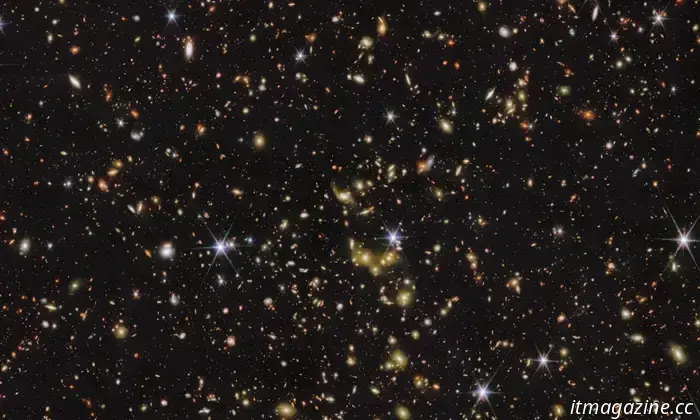
The James Webb Space Telescope has captured yet another breathtaking image featuring thousands of far-off galaxies.
The latest Picture of the Month from the NASA/ESA/CSA James Webb Space Telescope showcases an impressive array of galaxies. The objects captured in this image vary significantly in distance, ranging from stars within our Milky Way, characterized by diffraction spikes, to galaxies that are billions of light-years away.
This fresh image from the James Webb Space Telescope reveals a dazzling backdrop filled with thousands of galaxies, featuring a particular galactic group that is part of the COSMOS-Web field. This group is situated far enough away that we are observing it as it appeared when the universe was just half its present age. This capability is one of Webb’s key strengths; it allows the telescope to view objects so distant that it is akin to looking back in time. This occurs because light takes time to travel from these far-off objects to us, so what we see is how they looked when the light was emitted. Observing sufficiently distant objects enables a glimpse of their earlier states in the universe.
The COSMOS-Web survey harnesses this ability by aggregating data from different space telescopes, such as Webb and the Hubble Space Telescope, which observe infrared and optical wavelengths respectively, along with the European Space Agency’s XMM-Newton observatory, which observes X-ray wavelengths. For this survey, these various telescopes are focused on a specific region of the sky, known as a field, to collect data on galaxy groups and investigate the formation and evolution of these massive structures.
Thanks to Webb’s extensive sensitivity, the survey has detected galaxy groups from the first 2 billion years of the universe, when it was only 14% of its current age. By examining these early stages of the universe, researchers aim to gain deeper insights into how galaxies form and how they aggregate into groups, ultimately contributing to vast structures known as clusters that can contain thousands of gravitationally bound galaxies.
A secondary version of the image illustrates how various telescopes collaborate on this research, presenting Webb’s observations alongside a purple area indicating hot gas emitting X-rays, as recorded by both XMM-Newton and another X-ray observatory, Chandra.
This image integrates infrared data from Webb’s Near-InfraRed Camera (NIRCam) with additional infrared observations from the Hubble Space Telescope. The purple highlights reveal the presence of hot gas located within the X-ray galaxy group. These X-ray measurements are provided by the ESA’s XMM-Newton space observatory, with contributions from NASA’s Chandra X-ray Observatory.
The presence of this hot gas is significant because researchers recognize that many galaxy clusters contain vast amounts of intergalactic gas, which could influence how galaxies form stars and evolve. Scientists are still striving to comprehend why this gas remains so heated, despite the expectation that it should cool over time. Observations indicate that the gas within some clusters appears to be “sloshing around,” affected by the immense gravitational forces resulting from galaxies colliding and merging.
Georgina has served as the space writer for Digital Trends for the past six years, covering topics related to human space exploration and planetary science.
James Webb captures a spectacular view of the mesmerizing Flame Nebula.
Our universe is filled with numerous beautiful and intriguing objects, and we are fortunate to observe many of these using advanced instruments like the James Webb Space Telescope. A new Webb image presents a fresh perspective of the stunning Flame Nebula, an emission nebula situated in the constellation of Orion. This nebula serves as a bustling stellar nursery, where many new stars are being born. However, in this instance, researchers focused on studying objects known as brown dwarfs. These celestial bodies are larger than most planets but smaller than stars and are often referred to as failed stars since they lack the mass necessary to sustain nuclear fusion in their cores.
One of the most renowned and beautiful cosmic phenomena is showcased in this new image from the Hubble Space Telescope, highlighting the Veil Nebula’s vibrant colors. The Veil Nebula is the remnant of a massive star that exploded in a supernova approximately 10,000 years ago, leaving behind a striking structure of dust and gas that has a delicate, draped appearance, which is how the nebula earned its name. The original star was enormous, possessing 20 times the mass of the sun, and its explosion would have appeared more brilliant than Venus in the Earth’s sky, despite being located 2,400 light-years away. Over time, the aftermath of this explosion has continued to expand, shaping the structure we observe today.
This beautiful new image from the Hubble Space Telescope reveals cosmic dust, which was once viewed merely as an obstruction. For many years, astronomers considered dust a nuisance that blocked significant celestial objects from view. However, recent research has uncovered dust's vital role in star and planet formation, as well as in creating new molecules in space. The image captures clouds of dust and gas located near the Tarantula Nebula, a region also celebrated for its beauty. This area is part of a






Other articles
 iPhone prices are rising, but not for the reasons you might assume.
A recent report indicates that the average cost of iPhones has risen.
iPhone prices are rising, but not for the reasons you might assume.
A recent report indicates that the average cost of iPhones has risen.
 NYT Connections: clues and solutions for Wednesday, April 30.
Connections is the latest puzzle game from the New York Times, and it can be pretty challenging. If you require assistance in solving today's puzzle, we're here to support you.
NYT Connections: clues and solutions for Wednesday, April 30.
Connections is the latest puzzle game from the New York Times, and it can be pretty challenging. If you require assistance in solving today's puzzle, we're here to support you.
 This 42-inch OLED gaming television from Samsung is currently on a nice sale.
The Samsung 42-inch S90D 4K OLED is currently discounted at Samsung and various other retailers. Priced at $900, it's best to purchase quickly to take advantage of this offer!
This 42-inch OLED gaming television from Samsung is currently on a nice sale.
The Samsung 42-inch S90D 4K OLED is currently discounted at Samsung and various other retailers. Priced at $900, it's best to purchase quickly to take advantage of this offer!
 This budget 4K television has become even more economical.
The Onn 50-inch 4K Roku TV is currently on sale for $200, reduced from its original price of $330. You can take advantage of this deal by buying it at Walmart.
This budget 4K television has become even more economical.
The Onn 50-inch 4K Roku TV is currently on sale for $200, reduced from its original price of $330. You can take advantage of this deal by buying it at Walmart.
 Sgt. Rock is no longer moving forward: DC Studios has decided not to proceed with the Luca Guadagnino film.
DC Studios has decided to halt the development of Luca Guadagnino's feature film adaptation of Sgt. Rock, which was set to star Colin Farrell.
Sgt. Rock is no longer moving forward: DC Studios has decided not to proceed with the Luca Guadagnino film.
DC Studios has decided to halt the development of Luca Guadagnino's feature film adaptation of Sgt. Rock, which was set to star Colin Farrell.
 NYT Strands for today: clues, spangram, and solutions for Wednesday, April 30.
Strands offers a challenging twist on the traditional word search from NYT Games. If you're having difficulty and can't figure out today's puzzle, we've got assistance and clues for you right here.
NYT Strands for today: clues, spangram, and solutions for Wednesday, April 30.
Strands offers a challenging twist on the traditional word search from NYT Games. If you're having difficulty and can't figure out today's puzzle, we've got assistance and clues for you right here.
The James Webb Space Telescope has captured yet another breathtaking image featuring thousands of far-off galaxies.
A recent image taken by the James Webb Space Telescope reveals thousands of galaxies sparkling in the cosmos.
